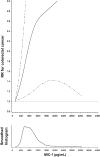A prospective study of macrophage inhibitory cytokine-1 (MIC-1/GDF15) and risk of colorectal cancer
- PMID: 24565956
- PMCID: PMC3982884
- DOI: 10.1093/jnci/dju016
A prospective study of macrophage inhibitory cytokine-1 (MIC-1/GDF15) and risk of colorectal cancer
Abstract
Background: Chronic inflammation plays a role in the development of colorectal cancer (CRC). The novel plasma inflammatory biomarker macrophage inhibitory cytokine-1 (MIC-1, GDF15) may have a direct mechanistic role in colorectal carcinogenesis.
Methods: We conducted a prospective, nested, case-control study of incident CRC among men and women who provided a prediagnostic blood specimen. We used an enzyme-linked immunosorbent assay to measure MIC-1 and examined associations between quintiles of MIC-1 and CRC using logistic regression adjusted for matching factors (age and date of blood draw), risk factors, and other plasma inflammatory markers. We also assessed the relationship between MIC-1 levels and prostaglandin-endoperoxide synthase 2 (PTGS2)/cyclooxygenase-2 (COX-2) enzyme status in tumors with available tissue for analysis. All statistical tests were two-sided.
Results: Compared with men and women within the lowest quintile of plasma MIC-1, the multivariable relative risk (RR) for CRC was 1.93 (95% confidence interval [CI] = 1.27 to 2.94) for the highest quintile (P linear trend = .004). In an exploratory analysis, we found that among individuals with high plasma MIC-1 levels (quintiles 2-5), compared with nonuse, regular use of aspirin and nonsteroidal anti-inflammatory drugs (NSAIDs) was associated with a lower risk of PTGS2-positive CRC (multivariable RR = 0.60; 95% confidence interval = 0.41 to 0.88) but not PTGS2-negative CRC (multivariable RR = 1.21; 95% CI = 0.71 to 2.07). In contrast, among individuals with low MIC-1 levels (quintile 1), aspirin and NSAID use was not associated with a lower risk of PTGS2-positive CRC (multivariable RR = 0.57; 95% CI = 0.21 to 1.54) or PTGS2-negative CRC (multivariable RR = 1.41; 95% CI = 0.47 to 4.23).
Conclusions: Our results support an association between higher levels of circulating MIC-1 (GDF15) and CRC. Aspirin/NSAID use appeared to lower risk of PTGS2-positive cancers, particularly among individuals with high levels of circulating MIC-1.
Figures

References
-
- Bernstein CN, Blanchard JF, Kliewer E, et al. Cancer risk in patients with inflammatory bowel disease: a population-based study. Cancer. 2001;91(4):854–862 - PubMed
Publication types
MeSH terms
Substances
Grants and funding
LinkOut - more resources
Full Text Sources
Other Literature Sources
Medical
Research Materials

